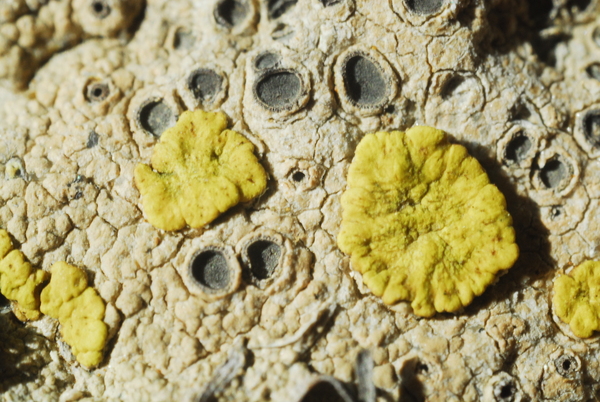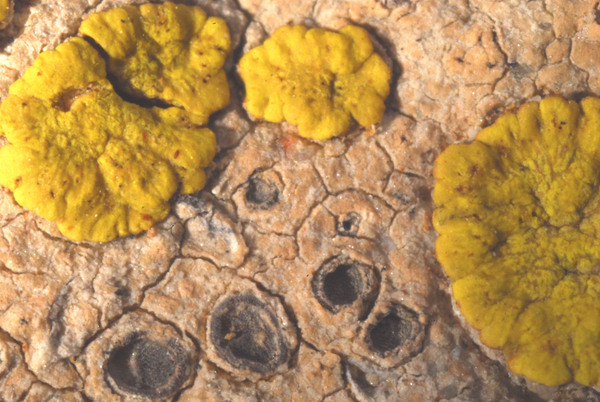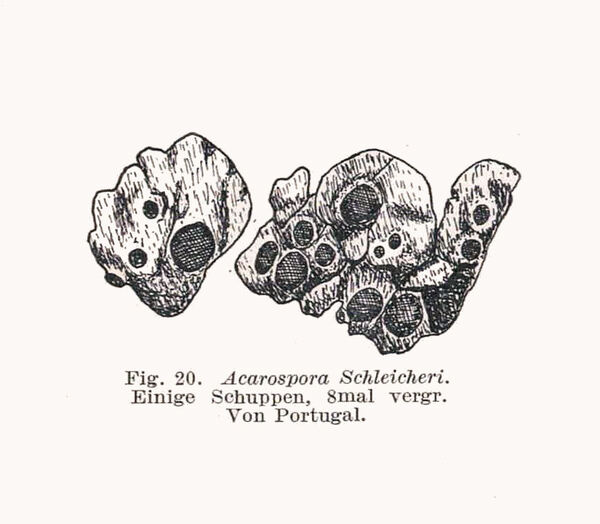Acarospora schleicheri (Ach.) A. Massal.
Ric. Auton. Lich. Crost.: 27, 1852. Basionym: Urceolaria schleicheri Ach. - Lichenogr. Univ.: 332, 1810.
Synonyms: Acarospora transtagatana (Harm.) Hue; Lecanora transtagatana Welw.
Distribution: C - Sar. S - Cal (Puntillo & Puntillo 2004), Si (Ottonello & al. 1994).
Description: Thallus crustose, episubstratic, areolate-subsquamulose, yellow to bleached yellow, often yellowish white in parts. Areoles 0.5-3(-5) mm wide, 0.2-0.4(-0.7) mm thick, flat to convex, often white-maculate, attached by anastomosing rhizohyphae, the peripheral ones often larger and indistinctly radiating. Cortex 40-80 μm thick, para- to prosoplectenchymatous; algal layer uneven, interrupted by hyphal bundles; medulla white, prosoplectenchymatous. Apothecia aspicilioid to lecanorine, immersed in the areoles, 1(-3) per areole, round to irregular, 0.4-1.2 mm across, with a flat to convex, brown to blackish brown, initially sometimes whitish-pruinose, rough disc, and a more or less raised thalline margin. Proper exciple poorly developed, 12-50 µm wide; epithecium yellowish brown; hymenium colourless, 80-130 μm high, I+ blue; paraphyses coherent, 1-2.3 μm thick at base, the apical cells only slightly wider; hypothecium colourless or yellowish grey. Asci 100-200-spored, clavate, the apical dome K/I-. Ascospores 1-celled, hyaline, broadly ellipsoid or subglobose, 3-4 x 2-3 μm. Photobiont chlorococcoid. Spot tests: thallus K-, C-, KC-, P-, UV+ orange. Chemistry: rhizocarpic acid.Note: a xeric subtropical species found on subneutral clay soil, decalcified ground over calcareous substrata, and weathered gypsum in open dry grasslands, common only in dry-continental areas, with optimum below the montane belt. To be looked for in dry-warm Alpine valleys.
Growth form: Crustose
Substrata: soil, terricolous mosses, and plant debris
Photobiont: green algae other than Trentepohlia
Reproductive strategy: mainly sexual
Subcontinental: restricted to areas with a dry-subcontinental climate (e.g. dry Alpine valleys, parts of Mediterranean Italy)
paras Diploschistes neutrophilus
Commonnes-rarity: (info)
Alpine belt: absent
Subalpine belt: absent
Oromediterranean belt: absent
Montane belt: absent
Submediterranean belt: extremely rare
Padanian area: absent
Humid submediterranean belt: absent
Humid mediterranean belt: extremely rare
Dry mediterranean belt: very rare

Predictive model
Herbarium samples
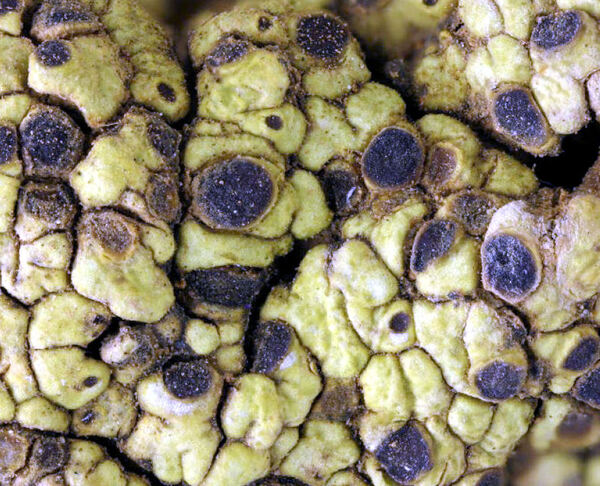

Felix Schumm CC BY-SA 4.0
[16335], Mallorca (Süd): Zwischen San Marina und La Lova des Llatres, lichtoffener Straßenrand; 39,39117° N, 2,76329° E, 100 m.
Leg. Schumm, Frahm & Lüth 12.03.2010, det.Schumm
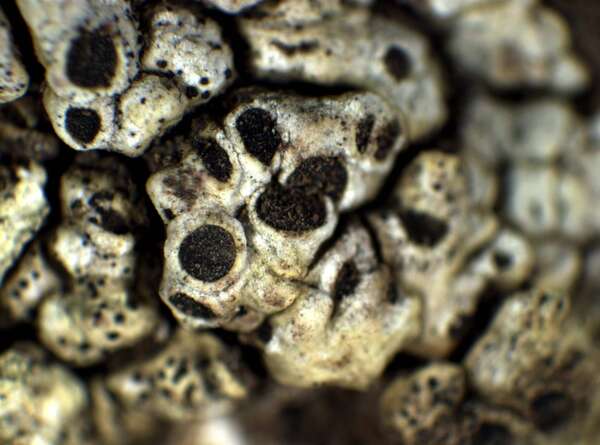

P.L. Nimis; Owner: Department of Life Sciences, University of Trieste
Herbarium: TSB (6909)
2001/11/21
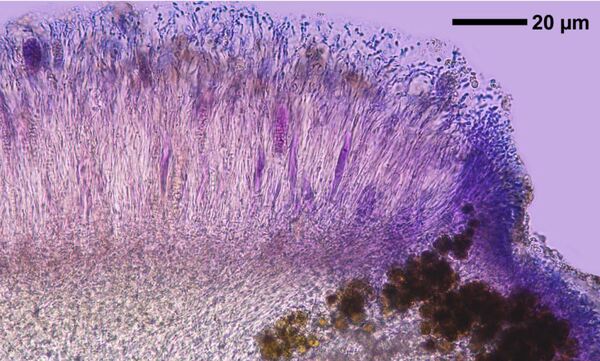

Felix Schumm – CC BY-SA 4.0
[16335], Mallorca (Süd): Zwischen San Marina und La Lova des Llatres, lichtoffener Straßenrand; 39,39117° N, 2,76329° E, 100 m. Leg. Schumm, Frahm & Lüth 12.03.2010, det.Schumm
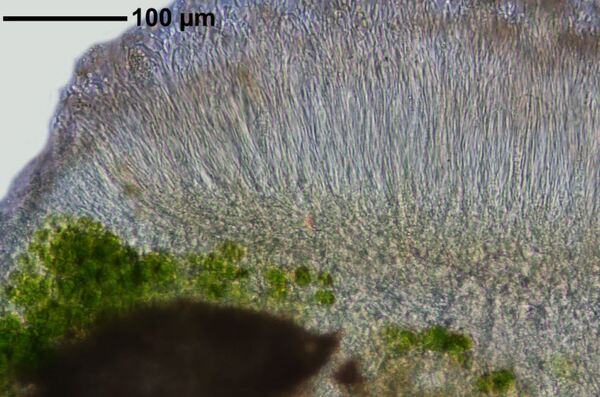

Felix Schumm – CC BY-SA 4.0
[16335], Mallorca (Süd): Zwischen San Marina und La Lova des Llatres, lichtoffener Straßenrand; 39,39117° N, 2,76329° E, 100 m. Leg. Schumm, Frahm & Lüth 12.03.2010, det.Schumm
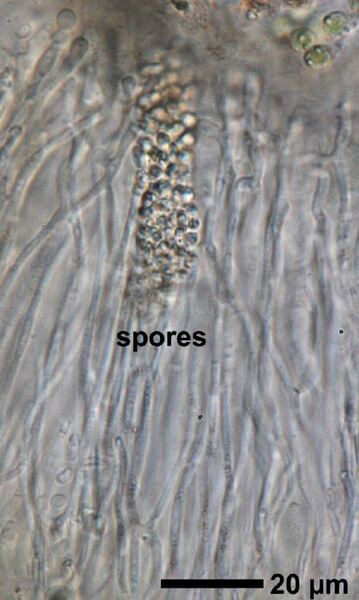

Felix Schumm – CC BY-SA 4.0
[16335], Mallorca (Süd): Zwischen San Marina und La Lova des Llatres, lichtoffener Straßenrand; 39,39117° N, 2,76329° E, 100 m. Leg. Schumm, Frahm & Lüth 12.03.2010, det.Schumm
Growth form: Crustose
Substrata: soil, terricolous mosses, and plant debris
Photobiont: green algae other than Trentepohlia
Reproductive strategy: mainly sexual
Subcontinental: restricted to areas with a dry-subcontinental climate (e.g. dry Alpine valleys, parts of Mediterranean Italy)
paras Diploschistes neutrophilus
Commonnes-rarity: (info)
Alpine belt: absent
Subalpine belt: absent
Oromediterranean belt: absent
Montane belt: absent
Submediterranean belt: extremely rare
Padanian area: absent
Humid submediterranean belt: absent
Humid mediterranean belt: extremely rare
Dry mediterranean belt: very rare

Predictive model
| Herbarium samples |


Felix Schumm CC BY-SA 4.0
[16335], Mallorca (Süd): Zwischen San Marina und La Lova des Llatres, lichtoffener Straßenrand; 39,39117° N, 2,76329° E, 100 m.
Leg. Schumm, Frahm & Lüth 12.03.2010, det.Schumm


P.L. Nimis; Owner: Department of Life Sciences, University of Trieste
Herbarium: TSB (6909)
2001/11/21


Felix Schumm – CC BY-SA 4.0
[16335], Mallorca (Süd): Zwischen San Marina und La Lova des Llatres, lichtoffener Straßenrand; 39,39117° N, 2,76329° E, 100 m. Leg. Schumm, Frahm & Lüth 12.03.2010, det.Schumm


Felix Schumm – CC BY-SA 4.0
[16335], Mallorca (Süd): Zwischen San Marina und La Lova des Llatres, lichtoffener Straßenrand; 39,39117° N, 2,76329° E, 100 m. Leg. Schumm, Frahm & Lüth 12.03.2010, det.Schumm


 Index Fungorum
Index Fungorum
 GBIF
GBIF
